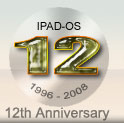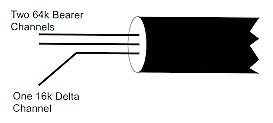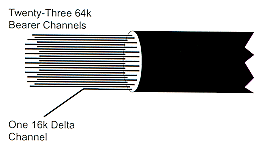
Last updated 8/3/1998
by Phil Becker
Copyright © 1996,1997 eSoft, Inc., All Rights Reserved. Permission granted to distribute this file in its entirety, without modification, to any interested party provided credit is given to eSoft, Inc. Any other use requires the written permission of eSoft, Inc.
IMPORTANT: The information herein is subject to change without notice. Please call or write to confirm factual information of importance to you or your organization.
ISDN (Integrated Services Digital Network) was initially developed
nearly 15 years ago, and reached its current electrical format over 10
years ago. However ISDN spent most of those years getting the hard
implementation and engineering problems solved while stalling out on the
apparently simple issues of protocol and configuration standardization
without which widespread adoption could not occur. The result was that
ISDN was a technology that was almost here
for what
seemed like forever.
Since 1985 over $100 billion has been invested in upgrading local TelCo switches to the SS7 (Signaling System 7) capability which allows clear channel 64kbps transmissions. However, without standards, ISDN remained a localized, difficult and expensive technology for an end user to access.
Starting with a demonstration event known as TRIP '92 in late 1992, the TelCos and ISDN equipment manufacturers began what proved to be effective moves towards cooperation on protocol and configuration standards known as National ISDN. Under the sponsorship of the Corporation for Open Systems, with the help of Bellcore in specifying and certifying compliance, the various players in the development and deployment of ISDN technology came together to do the hard work of standards development and deployment.
They divided the work into phases, so that targets for implementation could be focused upon and met. These phases were given the names National ISDN-1 (or NI-1), NI-2, etc. The first phase, NI-1, called for implementation of a uniform Basic Rate Interface (BRI) and the critical supplementary services required by it, and making available a Primary Rate Interface. The second phase, NI-2, includes a uniform PRI, consistent implementation of end-user services, and the availability of switched fractional DS1 services called Multirate ISDN. NI-3 (and later phases) will add end-user services.
Enough time has passed since the industry agreed on how to standardize, that we have reached the point where the benefits of such standards are now available. Once switch standards were set, manufacturers and TelCo's could begin developing, configuring, and deploying ISDN capable switch software, resulting in the real ISDN backbone capability which has now emerged. Once end-user standards started to coalesce, equipment manufacturers began to build more universally useful boxes. Finally, ( but by no means least important!) TelCo's developed procedures and began to train personnel to sell, install, and service ISDN.
We have reached the point where ISDN is largely deployed in the United States (and elsewhere too). In many places it has finally become available, usable and affordable. However, with every new technology comes new terms, buzzwords, and capabilities. This tutorial will orient you to ISDN so that you can understand the terms and capabilities of this medium.
The ISDN BRI (Basic Rate Interface) is the smallest unit of ISDN you can purchase. It is delivered over the same normal copper wires that you are used to in voice telephone service (or in TelCo jargon POTS - Plain Old Telephone Service). The copper wires connect to an interface known as an NT-1 (Network Termination-1) which converts the electrical signals on the copper wire into the digital signals which comprise the ISDN BRI connection. Your other equipment (ISDN phones, Digital data adapters, etc.) connect to the NT-1. While the NT-1 was a separate device on early ISDN adapters, all new ISDN devices have the NT-1 interface built in.
Because ISDN BRI service can be delivered over the same copper wires as normal telephone service, no special wiring is required for a BRI ISDN service hookup. This means that ISDN BRI service can be electrically deployed nearly anywhere in the U.S. today. In some areas local switches aren't quite ready to go, and thus obtaining BRI service is more difficult, but this will fade rapidly as deployment continues. And with the many ISDN anywhere programs that TelCo's are rolling out, you can usually get BRI ISDN service nearly anywhere today.
The BRI ISDN connection consists of two 64k Bearer channels, and one 16k Delta channel. Thus you often hear a BRI referred to as a 2B+D interface. The Delta channel provides an out of band signaling and control channel to manage the switching, thus you really receive two ISDN lines with a BRI ISDN connection. Along with allowing many interesting switching options, the D channel gives ISDN one of its obvious advantages — rapid call connection.
 BRI: Basic Rate Interface. Two bearer channels and one delta
channel form a single ISDN line. These channels are virtual in nature;
BRI is carried on a single physical pair of copper wires.
BRI: Basic Rate Interface. Two bearer channels and one delta
channel form a single ISDN line. These channels are virtual in nature;
BRI is carried on a single physical pair of copper wires. |
Dialing an ISDN line (some terms seem to transcend their technology, when did you last use a dial phone?) results in a connection in 2 to 3 seconds, rather than the 15 to 45 seconds of the normal telephone service connection. You will find this a joy the first time you make an ISDN call and see data flowing almost before your finger lifts from the Enter key after you type ATD123-4567. Because the signaling is all done on the D channel, you don't hear any dialing tones or ringing sound, as tones (or the older dialing pulses) are the in band signaling on a normal phone line which takes place digitally on the separate D channel with ISDN. These sounds may be synthesized for your benefit when you are making a voice phone call over ISDN, but they are just for your listening pleasure, not part of the actual calling function as they are on normal telephone circuits.
The two 64kbps B channels of a BRI ISDN connection may be divided up and used in a variety of ways. With an ISDN telephone, one B channel can be one voice telephone line of very high quality. In that mode it can interoperate with other analog phone circuits, replacing normal telephone service. In data mode, one Bearer circuit forms a 64kbps data channel, or both 64k Bearer circuits can be combined (or bonded) to form a single 128k data channel.
For those who want a lot of ISDN lines at one location, the PRI or Primary Rate Interface is appropriate. This interface uses 1.54 Mb DS1(T1) delivery techniques to provide 23 Bearer channels plus a Delta channel (23B+D) in a single cable connection. Through the use of hub units, these channels can be interfaced in nearly any combination you desire, and ISDN PBX equipment allows some very sophisticated switching options, with many more on the way soon. The single D channel handles switching and control for all 23 B channels in the PRI.
 PRI: Primary Rate Interface. One delta channel, and 23 bearer channels.
PRI: Primary Rate Interface. One delta channel, and 23 bearer channels. |
The PRI (Primary Rate Interface) is thus the ISDN logical equivalent of the T1 and channel bank method of delivering many voice phone lines over a single wire that has been used for some time to cut phone wiring costs. In short, it is an economical way to bring many ISDN lines into a single location on far fewer wires than installing each pair as a BRI. In use, the 23 ISDN circuits delivered by a PRI are identical to the two in a BRI.
For an end user, however, ISDN presents a problem that we have seen before with modems - too many choices. This results in confusing, difficult to order and configure service, as the customer has to learn way too much before they can successfully order and install ISDN service. The industry group has also begun to address this issue, through the use of what are known as ISDN Ordering Codes. An ISDN Ordering code represents a pre-established set of network services associated with specific customer premise equipment (CPE) for a specific application. This means that you can now buy ISDN adapters, call the TelCo and order ISDN service, and by giving them the ISDN Ordering Code that the manufacturer supplies, they will know how to configure the service options so your equipment will operate as you expect.
With 28.8k modems, analog modem technology over normal telephone service
has essentially reached its limits. Any improvements from here will be
minor, incremental, and more likely geared towards more reliable service
rather than significantly faster service. The new competing 56k standards
require digital connections at the provider's end, and still meet with the
limitations of certain analog lines that prevent today's 28k and 33k
modems from making full speed connections. ISDN will be one way that
public data service at higher data speeds will be provided in the future.
It may also be used to make the digital portion of the provider connection
for 56k analog
technology. The costs of ISDN are trending
towards those of normal phone service in many areas, and may converge in
time. When you remember that you buy two phone lines at once with ISDN,
BRI service is already often equivalent to normal phone service in price
in many areas.
Although it has taken nearly 15 years for ISDN to reach the point where you can find someone who is using it, it seems probable to me that its advantages will now follow the model of the Internet in flashing over into mainstream availability and adoption. I hope this tutorial will de-mystify it for you so that you can properly evaluate its use in your circumstances.
For assistance in providing information for this article, we thank:
Copyright © 1998 eSoft, Inc., all rights reserved. eSoft, the eSoft logo, and IPAD are trademarks of eSoft, Inc.